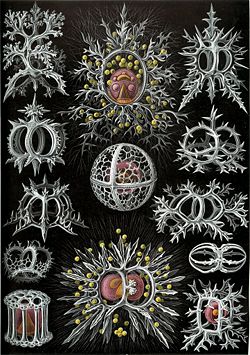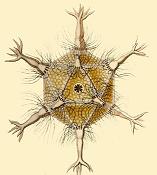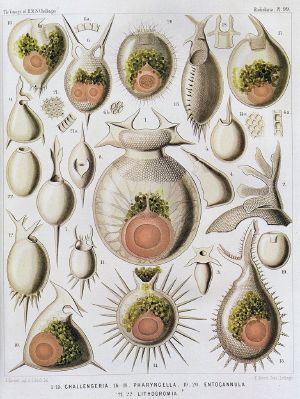Difference between revisions of "Radiolaria" - New World Encyclopedia
Rick Swarts (talk | contribs) |
Rick Swarts (talk | contribs) |
||
| Line 23: | Line 23: | ||
Radiolarians are amoeboid protozoa. [[Protozoa]] is a diverse group of single-[[cell (biology)|celled]], microscopic or near-microscopic [[eukaryote]]s (organisms whose cells have [[cell nucleus|nuclei]]) that commonly show characteristics usually associated with [[animal]]s, most notably [[mobility]] and [[heterotroph]]y. Protozoa span several [[Taxonomy#Scientific or biological classification|phyla]], which are generally placed as part of the kingdom [[Protista]], rather than the kingdom [[Animalia]]. Protista (or Protoctista) comprises those eukaryotes that are not [[animal]]s, [[plant]]s, or [[fungi]], and is not a natural (monophyletic group), but rather the "left-overs" from other eukaryotic kingdoms. | Radiolarians are amoeboid protozoa. [[Protozoa]] is a diverse group of single-[[cell (biology)|celled]], microscopic or near-microscopic [[eukaryote]]s (organisms whose cells have [[cell nucleus|nuclei]]) that commonly show characteristics usually associated with [[animal]]s, most notably [[mobility]] and [[heterotroph]]y. Protozoa span several [[Taxonomy#Scientific or biological classification|phyla]], which are generally placed as part of the kingdom [[Protista]], rather than the kingdom [[Animalia]]. Protista (or Protoctista) comprises those eukaryotes that are not [[animal]]s, [[plant]]s, or [[fungi]], and is not a natural (monophyletic group), but rather the "left-overs" from other eukaryotic kingdoms. | ||
| − | One of the taxonomic subgroups of protozoa that is commonly recognized is Sarcodina, which are those protozoans that move by cytoplasmic projection or pseudopods. That is, the amoeboid protozoa are traditionally grouped as the Sarcodina. Amoeboid means those cells that | + | One of the [[taxonomy|taxonomic]] subgroups of protozoa that is commonly recognized is Sarcodina, which are those protozoans that move by cytoplasmic projection or pseudopods (false feet). That is, the ''amoeboid protozoa'' are traditionally grouped as the Sarcodina. Amoeboid means those cells that project their cytoplasm, resembling limbs, to move around and engulf food particles. Sarcodina is ranked anywhere from a phylum to a subphylum to a class. Radiolarians are placed within the Actinopodea group within Sarcodina, with actinopods being those where the pseudopods are supported by regular arrays of microtubles. However, some newer taxonomic schemes do not recognize Sarcodina as a classification, because it is based on from rather than ancestral connectedness (phylogeny). Some do recognize two major groups of amoeboid protozoa, with the radiolarians included within the supergroup Rhizaria. |
==Description== | ==Description== | ||
[[Image:Radiolaria.jpg|thumb|left|Radiolaria illustration from the [[Challenger Expedition|Challenger Expedition 1873-76]].]] | [[Image:Radiolaria.jpg|thumb|left|Radiolaria illustration from the [[Challenger Expedition|Challenger Expedition 1873-76]].]] | ||
| − | Radiolarians have many needle-like [[pseudopod]]ia supported by bundles of [[microtubule]]s, called [[axopod]]s, which aid in flotation | + | Radiolarians have many needle-like [[pseudopod]]ia supported by bundles of [[microtubule]]s, called [[axopod]]s, which aid in flotation. |
| − | The | + | A characteristic feature of radiolarians is a membraneous capsule that separates the outer, frothy later of cytoplasm (ectoplasm or extracapusulum) from the central mass of cytoplasm (endoplasm) within the capsule. The [[cell nucleus|nuclei]] and most other [[organelle]]s are in the endoplasm, while the ectoplasm is filled with frothy [[vacuole]]s and [[lipid]] droplets, keeping them buoyant. The axopods are found in the ectoplasm and here digestion typically occurs. Often the ectoplasm also contains [[symbiosis|symbiotic]] [[algae]], especially [[zooxanthella]]e, which provide most of the cell's energy. |
| − | Traditionally the radiolarians have also included the [[Phaeodarea]], which produce siliceous skeletons but differ from the polycystines in several other respects. However, on [[molecular tree]]s they branch with the [[Cercozoa]], a group including various [[flagellate]] and [[amoeboid]] [[protist]]s. | + | Some of this organization is found among the [[heliozoa]]. Heliozoans are roughly spherical amoeboids with many stiff, microtubule-supported projections called axopods radiating outward from the cell surface. These give them the characteristic sun-like appearance for which they are named, and are variously used for capturing food, sensation, movement, and attachment. They are similar to radiolaria, but they are distinguished from them by lacking central capsules and other complex skeletal elements, and they only produce simple scales and spines. |
| + | |||
| + | Radiolarians almost exclusively have been found in ocean enviroments and as part of the [[plankton]]. | ||
| + | |||
| + | The two main groups of radiolarians, generally recognized as classes, are the Polycystinea and Phaeodarea. | ||
| + | |||
| + | The main [[Class (biology)|class]] of radiolarians are the [[Polycystine]]a, which produce [[Silica|siliceous]] skeletons. These include the majority of [[fossil]]s. They also include the [[Acantharea]], which produce skeletons of [[strontium sulfate]]. Despite some initial suggestions to the contrary, genetic studies place these two groups close together. They also include the peculiar genus ''[[Sticholonche]]'', which lacks an internal skeleton and so is usually considered a heliozoan. | ||
| + | |||
| + | Traditionally the radiolarians have also included the [[Phaeodarea]], which produce siliceous skeletons but differ from the polycystines in several other respects. However, on [[molecular tree]]s they branch with the [[Cercozoa]], a group including various [[flagellate]] and [[amoeboid]] [[protist]]s. The other radiolarians appear near, but outside, the Cercozoa, so the similarity is considered due to [[convergent evolution]]. The radiolarians and Cercozoa are included within a supergroup called the [[Rhizaria]]. | ||
Some radiolarians are known for their resemblance to [[regular polyhedra]], such as with this icosahedron shaped one. | Some radiolarians are known for their resemblance to [[regular polyhedra]], such as with this icosahedron shaped one. | ||
| Line 54: | Line 62: | ||
== References == | == References == | ||
| − | + | * Adl, S. M., A. G. B. Simpson, M. A. Farmer, R. A. Andersen, et al. 2005. [http://www.blackwell-synergy.com/doi/abs/10.1111/j.1550-7408.2005.00053.x The new higher level classification of eukaryotes with emphasis on the taxonomy of protists]. ''Journal of Eukaryotic Microbiology'' 52(5): 399-451. | |
| − | * | + | |
| − | + | * Haeckel, E. 2005. ''Art Forms from the Ocean: The Radiolarian Atlas of 1862''. Munich: Prestel Verlag. ISBN 3791333275. | |
| − | + | ||
| − | + | * Lopez-Garcia, P. et al. 2002. Toward the monophyly of Haeckel's radiolaria: 18S rRNA environmental data support the sisterhood of Polycystinea and Acantharea. ''Molecular Biology and Evolution'' 19(1): 118-121. | |
| − | + | ||
| − | + | * Towle, A. 1989. ''Modern Biology''. Austin: Holt, Rinehart and Winston. ISBN 0030139198. | |
| − | + | ||
| − | + | * Zettler, L. A. 1997. Phylogenetic relationships between the Acantharea and the Polycystinea: A molecular perspective on Haeckel's Radiolaria. ''Proceedings of the National Academy of Sciences'' 94: 11411-11416. | |
| − | |||
| − | |||
| − | |||
| − | |||
| − | |||
| − | * | ||
| − | |||
| − | |||
| − | |||
| − | |||
| − | |||
| − | |||
| − | |||
| − | |||
==External links== | ==External links== | ||
| − | + | ||
| − | *[http://hoopermuseum.earthsci.carleton.ca/2001_radiolarians_bb/ Radiolarians] | + | *[http://hoopermuseum.earthsci.carleton.ca/2001_radiolarians_bb/ Radiolarians]. Retrieved October 4, 2007. |
| − | *[http://www.microscopy-uk.org.uk/mag/artfeb05/cbdiatoms.html Geometry and Pattern in Nature 3: The holes in radiolarian and diatom tests] | + | *[http://www.microscopy-uk.org.uk/mag/artfeb05/cbdiatoms.html Geometry and Pattern in Nature 3: The holes in radiolarian and diatom tests]. Retrieved October 4, 2007. |
| − | *[http://www.radiolaria.org/ Radiolaria.org] | + | *[http://www.radiolaria.org/ Radiolaria.org]. Retrieved October 4, 2007. |
| − | *[http://caliban.mpiz-koeln.mpg.de/~stueber/haeckel/radiolarien/ Ernst Haeckel: Die Radiolarien (RHIZOPODA RADIARIA) Berlin, 1862] | + | *[http://caliban.mpiz-koeln.mpg.de/~stueber/haeckel/radiolarien/ Ernst Haeckel: Die Radiolarien (RHIZOPODA RADIARIA) Berlin, 1862]. Retrieved October 4, 2007. |
| − | *[http://www.pirx.com/droplet/radiolaria.html Radiolaria - Droplet] | + | *[http://www.pirx.com/droplet/radiolaria.html Radiolaria - Droplet]. Retrieved October 4, 2007. |
[[Category:Life sciences]] | [[Category:Life sciences]] | ||
| − | {{credit|Radiolarian|159900292}} | + | {{credit|Radiolarian|159900292|Heliozoa|145257646|Amoeboid|161206560}} |
Revision as of 13:52, 4 October 2007
| Radiolaria
| ||||||
|---|---|---|---|---|---|---|
 Plate from Ernst Haeckel's 1904 Kunstformen der Natur (Artforms of Nature), showing radiolarians belonging to the superfamily Stephoidea.
| ||||||
| Scientific classification | ||||||
| ||||||
|
Polycystinea |
Radiolaria is a diverse grouping of mostly marine amoeboid protozoa that produce intricate mineral skeletons, typically with a central capsule of cytoplasm separating the cell into inner and outer cytoplasmic portions, called endoplasm (with nuclei) and ectoplasm (or extracapsulum). As protozoans, radiolarians are tiny, single-celled eukaryotes and as ameboids they move or feed by temporary projections called pseudopods (false feet). Since there are diverse taxonomic schemes used for protozoans, which span several phyla, the radiolarians are diversely classified as well, ranging from being considered a phylum, to being a subclass of Actinopodea, to not being recognized as a natural taxonomic group.
Radiolarians are found as zooplankton throughout the ocean. Because they are found as far back as the early Paleozoic, are highly diverse, and there is a rapid turn-over of species, their siliceous skeletons (tests) are important diagnostic fossils. Some common radiolarian fossils include Actinomma, Heliosphaera and Hexadoridium.
Overview
Radiolarians are amoeboid protozoa. Protozoa is a diverse group of single-celled, microscopic or near-microscopic eukaryotes (organisms whose cells have nuclei) that commonly show characteristics usually associated with animals, most notably mobility and heterotrophy. Protozoa span several phyla, which are generally placed as part of the kingdom Protista, rather than the kingdom Animalia. Protista (or Protoctista) comprises those eukaryotes that are not animals, plants, or fungi, and is not a natural (monophyletic group), but rather the "left-overs" from other eukaryotic kingdoms.
One of the taxonomic subgroups of protozoa that is commonly recognized is Sarcodina, which are those protozoans that move by cytoplasmic projection or pseudopods (false feet). That is, the amoeboid protozoa are traditionally grouped as the Sarcodina. Amoeboid means those cells that project their cytoplasm, resembling limbs, to move around and engulf food particles. Sarcodina is ranked anywhere from a phylum to a subphylum to a class. Radiolarians are placed within the Actinopodea group within Sarcodina, with actinopods being those where the pseudopods are supported by regular arrays of microtubles. However, some newer taxonomic schemes do not recognize Sarcodina as a classification, because it is based on from rather than ancestral connectedness (phylogeny). Some do recognize two major groups of amoeboid protozoa, with the radiolarians included within the supergroup Rhizaria.
Description
Radiolarians have many needle-like pseudopodia supported by bundles of microtubules, called axopods, which aid in flotation.
A characteristic feature of radiolarians is a membraneous capsule that separates the outer, frothy later of cytoplasm (ectoplasm or extracapusulum) from the central mass of cytoplasm (endoplasm) within the capsule. The nuclei and most other organelles are in the endoplasm, while the ectoplasm is filled with frothy vacuoles and lipid droplets, keeping them buoyant. The axopods are found in the ectoplasm and here digestion typically occurs. Often the ectoplasm also contains symbiotic algae, especially zooxanthellae, which provide most of the cell's energy.
Some of this organization is found among the heliozoa. Heliozoans are roughly spherical amoeboids with many stiff, microtubule-supported projections called axopods radiating outward from the cell surface. These give them the characteristic sun-like appearance for which they are named, and are variously used for capturing food, sensation, movement, and attachment. They are similar to radiolaria, but they are distinguished from them by lacking central capsules and other complex skeletal elements, and they only produce simple scales and spines.
Radiolarians almost exclusively have been found in ocean enviroments and as part of the plankton.
The two main groups of radiolarians, generally recognized as classes, are the Polycystinea and Phaeodarea.
The main class of radiolarians are the Polycystinea, which produce siliceous skeletons. These include the majority of fossils. They also include the Acantharea, which produce skeletons of strontium sulfate. Despite some initial suggestions to the contrary, genetic studies place these two groups close together. They also include the peculiar genus Sticholonche, which lacks an internal skeleton and so is usually considered a heliozoan.
Traditionally the radiolarians have also included the Phaeodarea, which produce siliceous skeletons but differ from the polycystines in several other respects. However, on molecular trees they branch with the Cercozoa, a group including various flagellate and amoeboid protists. The other radiolarians appear near, but outside, the Cercozoa, so the similarity is considered due to convergent evolution. The radiolarians and Cercozoa are included within a supergroup called the Rhizaria.
Some radiolarians are known for their resemblance to regular polyhedra, such as with this icosahedron shaped one.
Haeckel's radiolarians
German biologist Ernst Haeckel produced exquisite (and perhaps somewhat exaggerated) drawings of radiolaria, helping to popularize these protists among Victorian parlor microscopists alongside foraminifera and diatoms.
Illustrations from Kunstformen der Natur (1904)
ReferencesISBN links support NWE through referral fees
- Adl, S. M., A. G. B. Simpson, M. A. Farmer, R. A. Andersen, et al. 2005. The new higher level classification of eukaryotes with emphasis on the taxonomy of protists. Journal of Eukaryotic Microbiology 52(5): 399-451.
- Haeckel, E. 2005. Art Forms from the Ocean: The Radiolarian Atlas of 1862. Munich: Prestel Verlag. ISBN 3791333275.
- Lopez-Garcia, P. et al. 2002. Toward the monophyly of Haeckel's radiolaria: 18S rRNA environmental data support the sisterhood of Polycystinea and Acantharea. Molecular Biology and Evolution 19(1): 118-121.
- Towle, A. 1989. Modern Biology. Austin: Holt, Rinehart and Winston. ISBN 0030139198.
- Zettler, L. A. 1997. Phylogenetic relationships between the Acantharea and the Polycystinea: A molecular perspective on Haeckel's Radiolaria. Proceedings of the National Academy of Sciences 94: 11411-11416.
External links
- Radiolarians. Retrieved October 4, 2007.
- Geometry and Pattern in Nature 3: The holes in radiolarian and diatom tests. Retrieved October 4, 2007.
- Radiolaria.org. Retrieved October 4, 2007.
- Ernst Haeckel: Die Radiolarien (RHIZOPODA RADIARIA) Berlin, 1862. Retrieved October 4, 2007.
- Radiolaria - Droplet. Retrieved October 4, 2007.
Credits
New World Encyclopedia writers and editors rewrote and completed the Wikipedia article in accordance with New World Encyclopedia standards. This article abides by terms of the Creative Commons CC-by-sa 3.0 License (CC-by-sa), which may be used and disseminated with proper attribution. Credit is due under the terms of this license that can reference both the New World Encyclopedia contributors and the selfless volunteer contributors of the Wikimedia Foundation. To cite this article click here for a list of acceptable citing formats.The history of earlier contributions by wikipedians is accessible to researchers here:
The history of this article since it was imported to New World Encyclopedia:
Note: Some restrictions may apply to use of individual images which are separately licensed.











